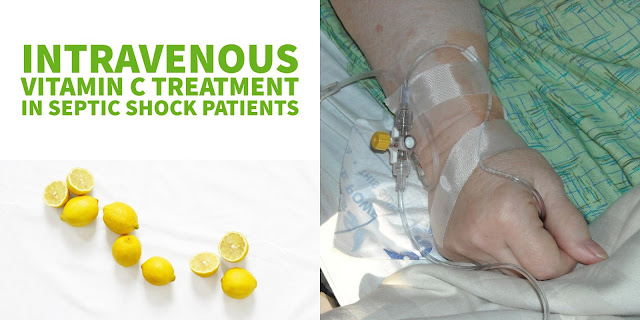- Get link
- Other Apps
- Get link
- Other Apps
 |
Intravenous Vitamin C Treatment |
Sepsis as a life-threatening syndrome caused by a dysregulated host response to infection. Septic shock is sepsis with underlying circulatory and cellular/metabolic abnormalities severe enough to substantially increase mortality. An evidence is emerging that intravenous administration of high-doses of vitamin C may have a beneficial effect and can be used as an adjuvant therapy of severe sepsis and septic shock.These Findings Published in International Journal of Microbiology & Advanced Immunology.
The global burden of sepsis and septic shock is about 15-19 million cases annually with a mortality rate around 60% in low-income countries.
100 patients with septic shock were enrolled, randomized into 2 groups.
Early vitamin C (EVC) group: 50 septic shock patients received intravenous 1.5 gm vitamin C (Ascorbic acid, Cevarol) every 6 hours in the first 24 hours after admission until ICU discharge plus conventional sepsis treatment. Control group: 50 septic shock patients received conventional sepsis treatment only. Norepinephrine was the vasopressor of the first choice and titrated to a dose of 20 μ/min targeting a mean arterial pressure > 65 mmHg. Conventional sepsis treatment in both groups was performed.
To identify the source of sepsis, all routine laboratory investigations and sepsis work up and all possible microbiological cultures prior to antibiotic administration or after discontinuation of antibiotic for 48 hrs. There was no significant difference between the two groups in the source of sepsis (p=0.088) Chest infections were the most common source of sepsis in both groups.
Intravenous Vitamin C Treatment
There are few studies on the effect of vitamin C in critically ill patients. Also, the outcome of these studies are difficult to interpret due to heterogeneous patient populations are included, different and mostly low doses of vitamin C are used, Most experience with adjuvant vitamin C has been obtained in cases of severe burn injury.
Using high doses of vitamin C to standard fluid resuscitation showed a significant reduction in fluid requirements and net fluid balance in an animal burn model. Two small studies in burn patients assessed the high-dose vitamin C as continuous infusion within the first day after the thermal injury.
One prospective study randomized patients to receive their fluid resuscitation alone or with vitamin C. Vitamin C treatment showed a reduction in resuscitation volume and resulted in better gas exchange and fewer days on mechanical ventilation.
In animal studies, intravenous vitamin C showed a rapidly and persistently improved capillary and microcirculatory blood flow and reduced inflammation.
Hyperoxaluria and formation of stones in the kidneys is a potential adverse effect associated with high doses of vitamin C administration. But, there were no any complications related to the high dose of vitamin C in EVC group studied in this trial. Under normal physiological conditions, 100-300 mg vitamin C per day is sufficient enough to reach adequate plasma concentration. But, critically ill patients may need up to 3 g daily to restore normal plasma concentrations.
The high dose of vitamin C infusion resulted in a 20-500 % increase in its plasma concentrations. Also, it is not known whether sepsis patients with normal to slightly decreased vitamin C plasma concentrations may benefit from high doses.
Conclusion
Early adjuvant high dose intravenous vitamin C treatment in patients with septic shock may resolve the vasopressor-dependent sepsis rapidly and decrease their ICU stay with no benefit on mortality.
This study was to evaluate the role of early intravenous high doses of vitamin C as adjuvant treatment in patients with septic shock. Published by SciDocPublishers.
- Get link
- Other Apps